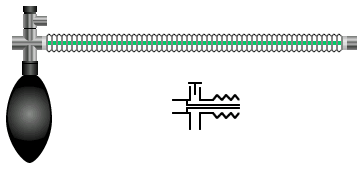|
Bain Circuit
A co-axial modification
of the basic T-piece system, developed to facilitate scavenging
of waste anesthetic gases.
Construction

An tube carrying
fresh gas (F) travels inside an outer reservoir tube (R) to the
endotracheal tube connector (P).
Function

Essentially,
the Bain circuit functions in the same way as the T-piece, except
that the tube supplying fresh gas to the patient is located inside
the reservoir tube.
Inspiration
-The patient inspires fresh gas from the outer reservoir tube.
Expiration - The patient expires into the reservoir tube.
Although fresh gas is still flowing into the system at this time,
it is wasted as it is contaminated by expired gas.
Expiratory pause - Fresh gas from the inner tube washes the
expired gas out of the reservoir tube, filling it with fresh gas
for the next inspiration.
Operational
requirements
- Generally
similar considerations apply as for the T-piece.
- Fresh
gas flow requirements--see separate article.
- The Bain
is more efficient at eliminating exhaled gas, since the fresh
gas is directed down the endotracheal tube, which reduces dead-space.
Modifications
A bag may be added to the tail of the reservoir tube, as in the
T-piece.

Alternatively,
the circuit may be attached to a block assembly with a pop-off valve
and mounted directly to the common gas outlet of the anesthesia
machine. This arrangement facilitates scavenging and intermittent
positive pressure ventilation.

Advantages
- Compact
and inexpensive.
- Low dead-space.
- Low resistance
to breathing.
- Facilitates
scavenging of waste gases.
Disadvantages
- High fresh
gas flow requirement in larger animals.
- High gas
flow rates, e.g. if the oxygen flush valve is used, may cause
lung barotrauma.
- As with
other co-axial systems, if the inner tube becomes disconnected
or breaks, the entire breathing tube becomes dead-space, leading
to severe alveolar hypoventilation. This may be detected in systems
fitted with a bag by closing the valve and activating the oxygen
quick-flush. If the inner tube is intact, the venturi effect of
the rapidly-moving stream of gas leaving the inner tube will suck
gas out of the bag and the bag will empty. If the inner tube is
damaged, the stream of gas will be directed into the bag and it
will fill.

Alternatively, the so-called 'parallel Bain' system may be used.
In this system, the inner and outer tubes are replaced by conventional
circle-absorber-type tubing and Y-piece. This arrangement is also
used in the Humphrey ADE system.

Uses
In small animals under 10 kg body weight.
Humphrey
ADE 
|






